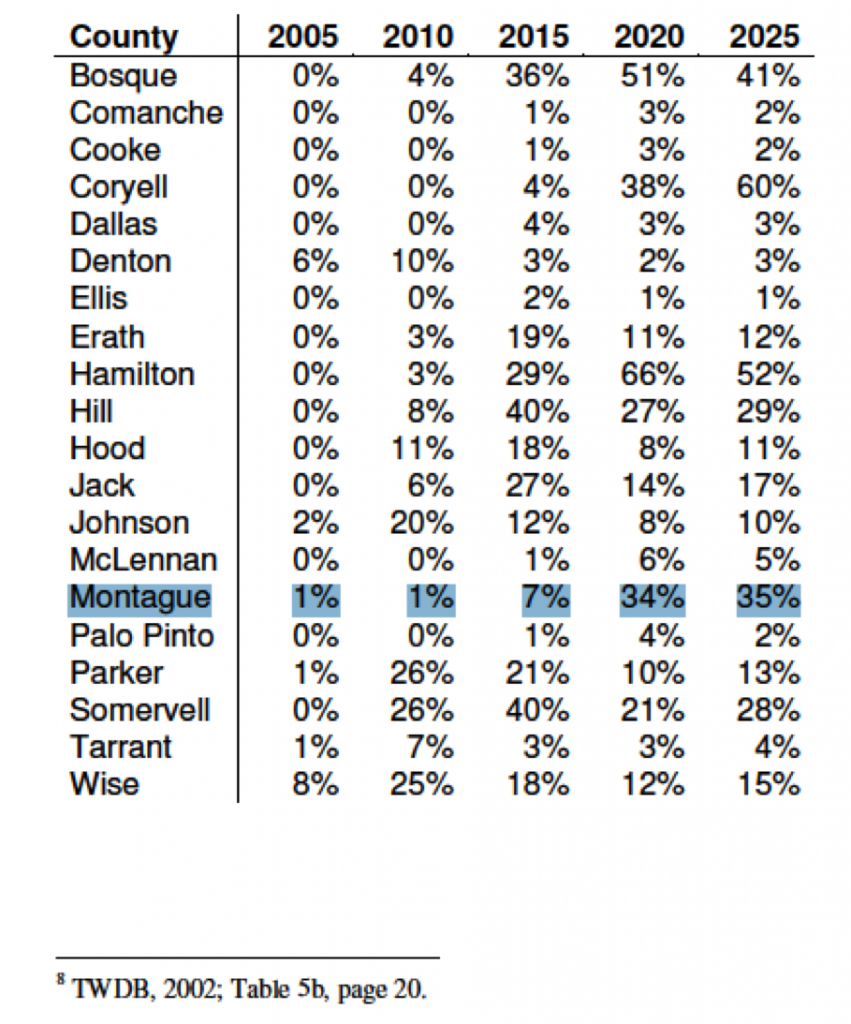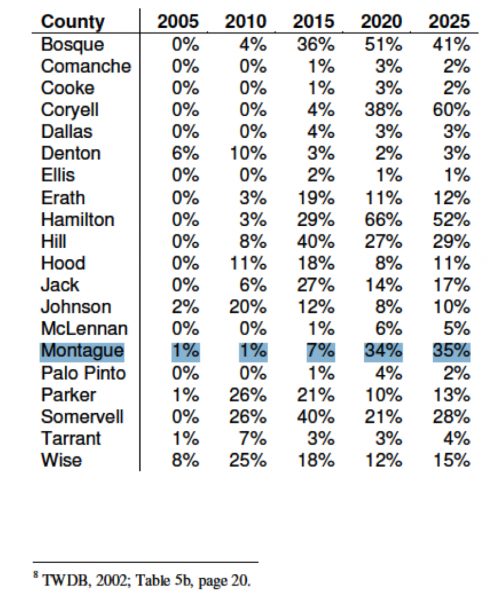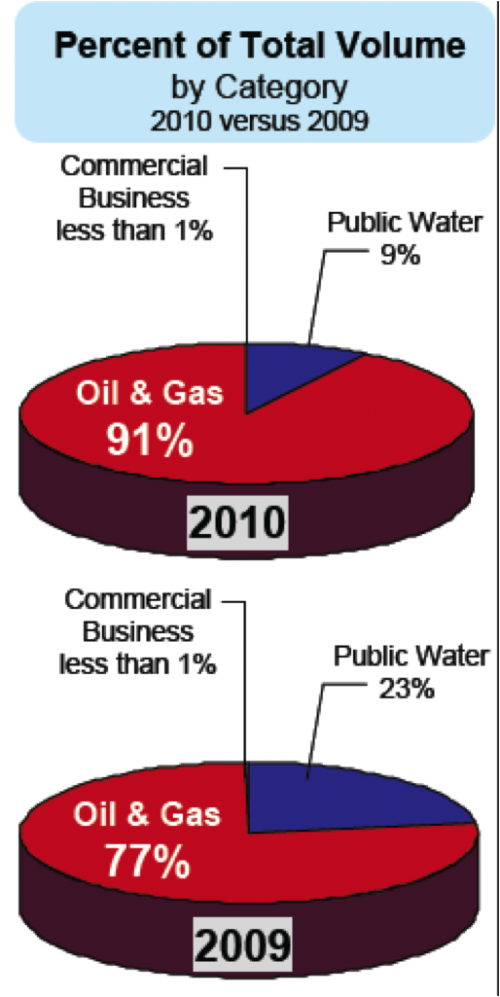
Clean water is a basic human right.
Crony Capitalism gives frackers control of Texas water budget.
Texas Governor Rick Perry is a co-owner of MKS Natural Gas Company. He just appointed Mary Ann Williamson, also a co-owner of MKS Natural Gas Company, to the Texas Water Development Board (TWDB).
To those who have fought Perry over the years, the relationship with MKS and the Williamsons remains shrouded in mystery, including how Perry landed the stake in the company in the first place. TheDailyBeast.com
This is not the first crony appointment for the Williamson family. Before his death in 2007, Perry appointed Mr. Williamson to the Texas Transportation Commission where he assisted Perry in his failed attempt to put the Trans Texas Corridor through. In 2008 he appointed Mrs. Williamson to the Texas Lottery Commission. Now she is overseeing our water.
Estimates are not measurements.
The TWDB claims that fracking uses only 1% of the water used in Texas and the media happily parrots that.
Studies say that fracking consumes less than 1 percent of the total water used statewide, far less than agriculture or even watering lawns. New York Times
There are three things wrong with that 1% figure.
- It’s not true. That is an estimate–an underestimate–given by the industry and repeated by the TWDB, not a number from metering.
- You can not compare the water used for fracking to other uses because it is a permanent withdrawal from our water budget.
- It paints a misleading picture. In some areas, fracking is sucking up all the water leaving residents with none.
How close are those TWDB estimates?
Highlighted on the chart above is Montague County, an agricultural county in the northern part of the Barnett Shale where, like the Eagle Ford, the shale is oily. The TWDB was a little off on their estimates for Montague.
In 2009, 77% of water used in Montague went to oil & gas production. In 2010, 91% of water used went to oil & gas production. (This was before the frack sand mine which is another tremendous water user.) Here’s how that looks in a graph from the Bowie News:
The TWDB estimates are not even close enough for government work.
The water used for fracking is not sustainable.
“We just can’t sustain it,” Hugh Fitzsimons, a Dimmit County bison rancher who serves on the board of his local groundwater district, said last month as he drove his pickup down a dusty road.
[…]
A study commissioned by his groundwater district found that in a five-county area that includes Dimmit, fracking reduces the amount of water in the Carrizo-Wilcox Aquifer by the equivalent of one-third of the aquifer’s recharge. New York Times
The water used to produce shale oil and gas is not sustainable. It’s reckless! For about 1.5 barrels of water you can have 1 barrel of oil.
In 2011, Texas used a greater number of barrels of water for oil and natural gas fracking (about 632 million) than the number of barrels of oil it produced (about 441 million), according to figures from the Texas Water Development Board and the Railroad Commission of Texas, the state’s oil and gas regulator. Texas Tribune
Apples are not oranges.
Remember, as I told you way, way back in 2007, before fracking was a household word: The water used for fracking is forever removed from our active hydrologic cycle. Fracking water use cannot be compared to water used for lawns and crop irrigation because that water is not a permanent withdrawal.
We need another way to calculate the water used by fracking. We need a modeling method that weights the usage to show, over time, how the permanent fracking withdrawals effect our water budget.
What about recycling or what is the meaning of is?
Industry likes to claim they recycle 100% of the water they use but that all depends on the definition of recycle and 100%.
The water used for fracking is not recycled back to potable water. It is not placed back into the aquifer. When industry talks about recycling they mean they reuse the water to frack another well, which is a good thing but there is a limit on how many times they can reuse the same water, about 1.5 to 2 times.
Depending on the formation and depending on who is talking, a percentage of the water used for fracking does not flowback up the hole but stays entombed in the formation. So they never recycle 100% because normally 100% does not come back to the surface.
Today recycling is only prevalent in the Marcellus shale, where about 90 percent of flowback water from wells is recycled, because there are few disposal wells in the region and water to be discarded must be trucked to Ohio to be injected underground. Reuters
90% of flowback ≠ 100% of frack water.
A single well hydrofracture in the Marcellus may require one to five million gallons of fracturing fluid, of which between 25 and 100 percent may be returned to the surface as “flowback” or “produced” water, which must then be disposed. NETL.doe.gov
Also, the water is not recycled to potable water standards and it’s not being injected back into the aquifer. It still requires disposal.
Rather than recycling it’s more accurate to say they reuse some of the water used for fracking then they dispose of it.
Keep your paws off our brackish water!
Another thing industry likes to brag about is their recent use of brackish water instead of fresh water.
David Blackmon, a managing director of FTI Consulting and a spokesman for the industry website Energy in Depth, said he expects that in three or four years the oil and gas industry will switch en mass to tapping brackish aquifers for hydraulic fracturing. The water versus energy paradox – Mywesttexas.com: Top
As we get thirstier and thirstier, what once was considered non-potable water is going to start looking mighty tasty. San Antonio is already using brackish water.
San Antonio Water System is currently developing a brackish groundwater desalination program in southern Bexar County. Brackish groundwater is a plentiful, previously untapped local source of water that will help diversify San Antonio’s supplies. Source
Marching orders:
- When the media tries to compare water used for fracking to water used for lawns, call them on it every time.
- Be clear that the figures given for water use are only estimates not measurements and that in local areas the usage can be intense.
- When industry talks about recycling, ask them what “is” is.
- Tell everyone that shale oil and gas development is causing water bankruptcy.
- End crony appointments that put corporations over people.
- And some other stuff I can’t think of right now.
In this post, I used fracking water generally but the water industry uses is far greater than just the water used for fracking. Stay tuned.
Update: Suggested addition from reader:
“In this episode of the Keiser Report, Max Keiser and Stacy Herbert discuss the ‘Sinkholes of Stupid’ causing collapse in Texas, where fracking has caused water shortages. In the second half, Max talks to Chris Martenson about the four signs of dangerous bubble territory, the markets oblivious to the costs of Fukushima meltdown and the bad economics of fracking.”
“Keiser Report: Sinkhole of Stupid”
Episode 490
August 29, 2013 08:30
About this: CH4 + 2 O2 -> CO2 + 2 H2O. See the comments.
About Sharon Wilson
Sharon Wilson is considered a leading citizen expert on the impacts of shale oil and gas extraction. She is the go-to person whether it’s top EPA officials from D.C., national and international news networks, or residents facing the shock of eminent domain and the devastating environmental effects of natural gas development in their backyards.
- Web |
- More Posts(5121)



Sharon
Those molecules of water in the ground are trapped forever. But to be fair burning methane that they have allowed out CREATES water.. And that goes into the active hydrological cycle..IT also of course creates CO2
CH4 + 2 O2 -> CO2 + 2 H2O.
(1carbon atom, 4 hydrogen atoms, 4oxygen atoms each side of the equation)
I’ve seen some numbers floating around the net about how much water is created if a Bcf of gas is burned but they seem really high. Is there a reliable unbiased source you trust I can check this against?
Thanks as always. Good to see you always vigilant.
Yeah, I’m aware of that equation that industry like to bandy about and there are some problems with it in REALITY. I was hoping to address this in another post.
1. Burning methane creates WATER VAPOR and WATER VAPOR is a POWERFUL Greenhouse Gas. We don’t need the oil & gas industry to create even more GHG!
2. WATER VAPOR does not always become rain.
3. When excessive amounts of water are pulled from aquifers in Texas to frack in Texas, then that fracked gas is transported to New York or even Asia, the WATER VAPOR is created there NOT here. Yes, I realize the WATER VAPOR could become rain that falls into the ocean which will be evaporated and form storms systems. BUT in case no one has noticed, the weather patterns have changed and those storm systems don’t seem to be finding their way to Texas to help alleviate our years long drought.
4. It can take a very long time for aquifers to recharge. So even if this WATER VAPOR becomes rain, and even if that rain finds its way to Texas, it will take a whole lot of it for a very long time to make up for the amount the frackers are pulling out of our aquifers.
So that equation is not helping regular Texans who are running out of water NOW.
Thanks Sharon. True points about where the vapour is made. After Sandy I guess NewYork needs more rain like hole n the head 🙂
Zinger post Sharon, thank you.
“And some other stuff I can’t think of right now.”
Oh, I just thought of something we may want to factor in to our “water budget.”
It’s bad enough companies are all over our freshwater like maggots on a carcass, but ramping up quakes may be another way we see our water disappear.
“Hydrogeologic responses to earthquakes have been known for decades, and have occurred both close to, and thousands of miles from earthquake epicenters. Water wells have become turbid, dry or begun flowing, discharge of springs and ground water to streams has increased and new springs have formed, and well and surface water quality have become degraded as a result of earthquakes.
Earthquakes affect our Earth’s intricate plumbing system–whether you live near the notoriously active San Andreas Fault in California, or far from active faults in Florida, an earthquake near or far can affect you and the water sources you depend on.
… The 1998 M5.2 Pymatuning earthquake in northwestern Pennsylvania caused about 120 local household-supply wells to go dry within 3 months after the earthquake (Fleeger and others, 1999). The 2002 M7.9 Denali Fault earthquake in Alaska caused a 2-foot water level rise in a well in Wisconsin, more than a thousand miles from the epicenter.”
http://pubs.usgs.gov/fs/fs-096-03/pdf/fs-096-03.pdf
“What happens above the Earth’s surface was dramatically apparent today in places from Mineral, Virginia, to Washington, D.C., but what’s not so obvious are impacts beneath the surface to groundwater, said the National Ground Water Association.
While it’s too early to assess in Virginia and surrounding environs, earthquakes commonly cause fluctuations in groundwater levels and damage to water wells systems, said NGWA Public Awareness Director Cliff Treyens.
‘Since aquifers are water-bearing subsurface formations, it makes sense that water levels and wells would be affected,’ Treyens said. “One well driller after a California quake cited a well that produced 60 gallons per minute prior to a moderate earthquake slowing down to ‘practically nothing’ after.
Sometimes the reason for such impacts is obvious. In bedrock formations, for instance, the well will be drilled until it hits a fracture or crevice that holds water. A moderate earthquake could easily alter that configuration, Treyens said.
Aquifers consisting of unconsolidated materials can compact, or become unstructured as a result of the seismic energy moving though them during the earthquake, in a process called ‘liquefaction.’ This results in a loss of storage for groundwater and subsidence on the ground’s surface.
While surface structures are often designed to be earthquake resistant, the same cannot be said of water well construction. The result is that often wells are destroyed. Earthquakes also can affect groundwater quality, sometimes causing turbid well water.”
http://www.ngwa.org/Media-Center/press/2011/Pages/Virginia-earthquake-could-affect-some-water-wells.aspx
“Mother Nature has apparently turned off the taps for a series of idyllic hot springs on a remote west coast B.C. island following Saturday’s 7.7 magnitude earthquake and aftershocks.
Four naturally-sourced pools on the tiny Hot Springs Island in Gwaii Haanas National Park, which have provided spiritual and medicinal comforts to locals and tourists for generations, have completely run dry.
‘They were wonderful, you would sit up above the cliff and watch the whales frolicking in the distance while getting nice and warm in the pool,’ said Barb Rowsell, a tour guide with Anvil Cove Charters.
‘Now there’s no water, gone,’ she said, adding perhaps it’s a warning nudge from the earth.
‘Hey you guys — behave yourselves a bit better. I’m going to take away some of your goodies.’
… The epicentre of the main earthquake to rock the region on Saturday was about 30 to 40 kilometres from the island, Gladstone said.
One aftershock, which had a magnitude between four and five, was less than one kilometre away.
‘Right now we’re assuming this is a result of the earthquake activity over the weekend and subsequent aftershocks,’ he said.
… Members from the Canadian Geological Survey are now trying to determine more precisely why the springs have stopped flowing, how the earthquake may have been involved, and whether the plug is permanent.
Seismologist Michael Bostock said it’s very likely there was a change in the stress patterns underlying the region when the quake occurred, and that impacts how fluids migrate through the earth’s crust.
Fractures that were previously opened may have closed, and new cracks may have formed, he said.
‘Certain pathways are no longer accessible by the water, and the earthquake may have damage and created other pathways through which is might have flown,’ said the earth and ocean sciences professor at the University of B.C.
He said it is possible the springs could return.
http://travel.ca.msn.com/halcyon-hot-springs-vanish-after-bc-quake-1
“Don’t hold your breath waiting for the famed Haida Gwaii hot springs to come back, says a Vancouver geologist in a new book.
… Geologists mused at the time that the underground reservoir was only temporarily depleted and the pools could fill again.
Now it seems more likely the cracks were closed during the quake.”
http://www.vancouversun.com/news/springs+Haida+Gwaii+could+gone+good/8789297/story.html
It is funny how deceiving you can be sharon.
I guess its not worth reporting that not all water used by oil and gas is potable water.
I guess its not worth reporting that oil and gas buys most of its water from WILLING sellers at a HIGH price.
I guess its not worth reporting that water for recreational use uses around 5-6% of statewide water.
But I see what you did there, you left many things out, you just reported half the story. But then again why would you report the whole story…Probably because your PAID FULL TIME to make it sound as bad as you can.
You are using multiple identities on my blog and requested that I delete your comment when you accidentally used your real name and I’M the one who is deceiving?
To address your comment, Tom, er JT, er…
I’m pretty sure if you re-read the post, you will see that I did address brackish water. Maybe read slowly or out loud.
What difference does it make that the industry buys water from greedy people who have no thought for their neighbors? That does not change any of the FACTS I wrote about.
Water used for recreational uses is not entombed forever in shale formations or in deep disposal/injection wells. What I wrote about above is the arrogance of altering our active hydrologic cycle.
You are right that I did not report the whole story. I left out the water used for drilling and the water used for pressurization and the water used to process the frack sand. Stay tuned.